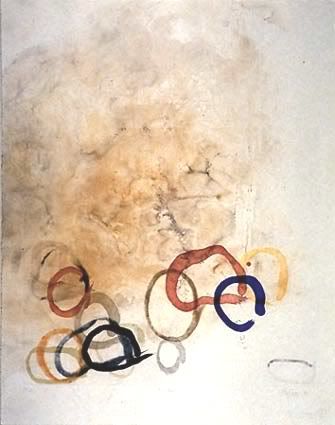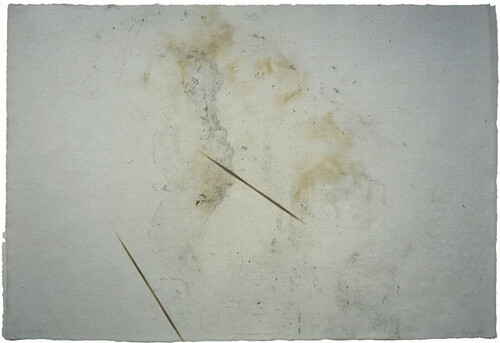
John Cage is best known as composer of 4'33, the composition that features 4 minutes and 33 seconds of silence. For those that don't know it, you enter the hall, the orchestra sits, the concert master comes to tune, the conductor appears and bows, raises his hands to begin and...
...then lowers them and looks at his watch.
Then there's nothing for the next four and a half minutes. Of course, we quickly see that it's not just silence, but in the context of aesthetic appreciation, it is filled with sound, humor, meaning and, yes, beauty.
John Cage teaches us to listen, in a very specific way and it's that silence that echoes...
But Cage was more than musical mad-scientist. He was a prolific multi-artist. And perhaps the most important one, in terms of his influence across all the arts, of the last 50 years.
(Listen/View a beautiful film inspired by Cage's aesthetics, with his piece "In a Landscape":)
Among the emerging artists of today, the experimenter, the wizard and witchdoctor is worshiped. We were a generation raised on pop culture, and when we were exposed to the likes of Cage, DuChamp, Jasper Johns, John Ashbury, Gertrude Stein...
...people totally reinventing art with howling at the moon madness, joie de vivre, where poetry meets its primitive heritage in the incantation, eye of noot, hair of toad, the dull pierce of the wolf's tooth. The "cut" of the haiku, which projects a silent image at the base of the skull. The tools that had flooded in from the east, which released the intuitive back into our art, remain the most exciting and inspiring thing that most young artists today will learn about in art/music/writing/dance/theater/etc school.
At its base, the aesthetic is this: something that cuts to the now, that, in an instant, frees us from some illusion that had held us living in the past or future. We discover that there is a raw mad magic to life just under the surface.
And so there is a generation that wants that freedom, and also enjoys Scooby doo.
Which has created a sort of paradox, apparent in artists ranging from Artist Banksy, to the Dresden Dolls and Franz Ferdinand, to Carole Maso, the Flarfist Collective, the White Stripes, Naomi Klein, Chuck Palahniuk, practically all new photography, the films of Kevin Smith, the Wachowski Brothers, the Coen Brothers and on and on and on. And the same is even more apparent in the youngest generation of artists I meet.
The paradox is this:
Wake-ism vs Dream-ism.
or the concrete vs the sentimental.
Or now vs the drama of learning from pasts and creating new futures.
So we are used to art sweeping us up in narrative. To "get lost" in an imaginary world created by a painting, a novel, a piece of music. We may walk around our entire lives living mostly in a world colored by these imaginary worlds, the sweet conflicts of our literature,
 witnessed in our own lives. But Art may also wake us up and alert us to the beauty and profound mystical quality of now. And in so doing, create the possibility that we can make our own way, not just live out the dramas of the past and the future we desire. Cage spoke of feeling that paintings wanted to manipulate him, hypnotize him into a fantasy world, whereas he would walk away from a DuChamp painting and suddenly THE REAL WORLD was more interesting. The DuChamp would point to the hidden beauty in cement, or in a door nob. And suddenly he was seeing things as they really are, not just as their trivial and passe "function:" "door nob."
witnessed in our own lives. But Art may also wake us up and alert us to the beauty and profound mystical quality of now. And in so doing, create the possibility that we can make our own way, not just live out the dramas of the past and the future we desire. Cage spoke of feeling that paintings wanted to manipulate him, hypnotize him into a fantasy world, whereas he would walk away from a DuChamp painting and suddenly THE REAL WORLD was more interesting. The DuChamp would point to the hidden beauty in cement, or in a door nob. And suddenly he was seeing things as they really are, not just as their trivial and passe "function:" "door nob."(John Cage speaking of this phenomenon in music, about 5 minutes)

This contradiction between (1) the "fictive dream," which has become so prevalent a tool in our advertising that we've become very suspicious of it, and (2) what moves us toward awake, remains one of the most important problems in emerging art.
------->While Cage, and the previous generation of experimenters were "purists" in their move toward "awake," the newest generation attempts to weave the two contrary elements together.
And it's here that Cage's influence echoes on. Through the paintings of Jasper Johns, who is a major influence on emerging artists and through noise rock, "Language Poetry," which sees raw language as its subject, instead of some romantic fictive dream, Opium Magazine, "Fluxus" and through the exploits of the cacophony society, which inspired Chuck Palahniuk.
How do various artists use/address/solve this apparent contradiction?
Cage pieces on Youtube:
Cage echoes here: (just a few Cage-inspired wonders...)
Woolgathersome ("Still lifes")
Joan Retellack poetry
Mac Low
http://mainstreampoetry.blogspot.com/






1 comment:
Thought I should add: the two paintings are by Cage as well. The first is 11 Stones in a Painting and believe the second is Variations 3, though I'll double check on that....
------->Alex
Post a Comment